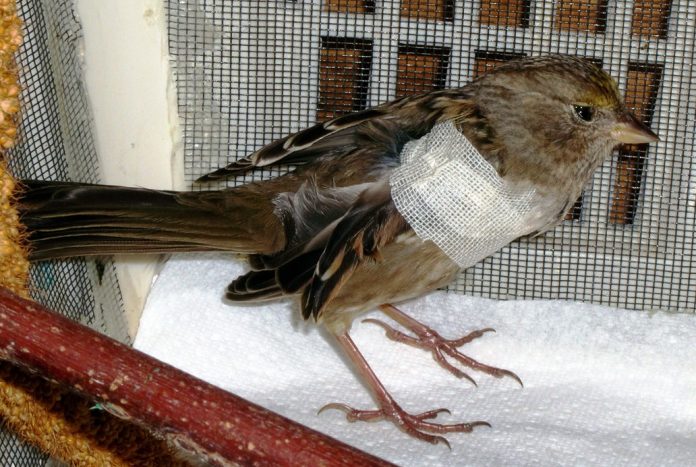
I am enjoying my morning coffee when I hear a sickening thud and the sound of something lightly sliding down the kitchen window. The window shakes ever so slightly. Before I can even look up from my newspaper, I realize a bird has struck the window. Looking outside, I see a trembling, dazed mockingbird on the walkway below. Fortunately, he is on his feet. I watch him for a few minutes to be sure none of my neighbor’s cats, who claim my yard as their own, find him. In a few minutes, thankfully, he is airborne again—hopefully wiser about windows and no worse for wear.
While this incident had a happy outcome, many bird strikes do not. Often, the bird breaks its neck or suffers a brain hemorrhage and is killed. It may break a wing, grounding it and making it easy prey for a predator. Occasionally, it may fly away but then die later from internal injuries. Bird strikes are not limited to homes in residential areas; they are equally common in large cities with high-rises.
According to the U.S. Fish and Wildlife Service, “One of the greatest hazards to birds is plate glass, with windows in homes and offices killing as many as one billion birds each year. Glass is invisible to birds and if it reflects the images of trees, bushes, the sky or other natural habitat, a bird may fly directly into it.” Or, the bird may only see the potted plants on the other side of the glass or the landscape on the other side of the window through a second window, and not realize the window is there.
Skyscrapers are especially dangerous to birds that migrate at night. Nocturnal migrators (for example, warblers, orioles and tanagers) navigate by the stars. According to the Cornell Lab of Ornithology, while some nighttime collisions appear to be simply random (the building just happens to be in the bird’s flight path), some nocturnal migrants appear to be lured by the lights. For reasons not entirely understood, the lights in tall buildings seem to be divert these birds from their original paths. The birds gather near the lights, often colliding with one another or the building. Sadly, there may be hundreds of dead birds littering the streets after such an event.
There is, of course, one simple solution to the problem of lighted skyscrapers—require building lights to be turned off at night, to the extent possible, especially when nocturnal migrators are in the air. Many cities now have regulations in place to minimize bird deaths in urban areas. Similar rules require lights to be turned off at night in beach communities when sea turtle eggs are hatching. The baby turtles follow the light of the reflected stars to the ocean; artificial lights confuse them and cause them to make the fatal mistake of moving away from the ocean, instead of toward it.
Occasionally, birds intentionally fly into windows. While annoying to people, and exhausting for the birds, these strikes are rarely fatal. Most common during breeding season, these birds are attacking what they believe to be a competitor. Birds that are very territorial and nest close to buildings, such as robins and towhees, do this most commonly. They see their reflection in the window and believe they are seeing another bird that must be chased away.
If you go outside and look at your windows, you will see what the birds see. Do you see plants and trees reflected in the glass? If so, the window presents a danger to birds.
There are hundreds of products on the market to help protect birds from windows. The goal is to make the window visible. If a window is so clean that birds cannot see it, or can only see what is reflected, birds will be more likely to fly into it. Window screens or tightly stretched netting (with spaces no larger than 5/8 of an inch) will allow a bird to bounce off a window without hurting himself. Other products, such as reflective decals applied no further apart than four inches, may alert birds to the window’s presence. The shape or design of the decal does not matter. Ultraviolet stickers, which humans cannot see but birds can, must be placed so close together that a bird could not fly in between them. External sunshades, shutters or awnings may also help.
If you find a bird that has struck a window, watch it for a while to protect it from any predators and see if it is able to fly away. If it is not, call a licensed wildlife rehabilitation center, such as WERC, for advice.
For more suggestions on protecting birds from windows, and what to do if you find a window-strike victim, go to allaboutbirds.org/Page.aspx?pid=1184.









